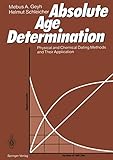Absolute age determination: physical and chemical dating methods and their application [Libro electrónico] / autores: Mebus A. Geyh, Helmut Schleicher
Por: Geyh, Mebus A [autor/a].
Schleicher, Helmut [autor/a].
Tipo de material: Libro
en línea Editor: New York, New York, United States: Springer-Verlag, c1990Descripción: xi, 503 páginas : ilustraciones mapas ; 25 centímetros.ISBN: 3540512764; 0387512764; 9783540512769 (Print); 9783642748264 (Online).Tema(s): Geochronometry | Radiocarbon datingNota de acceso: Disponible para usuarios de ECOSUR con su clave de acceso Nota de bibliografía: Incluye bibliografía e índice: páginas 381-444 Número de sistema: 56128Contenidos:Mostrar
Resumen:
Libro
en línea Editor: New York, New York, United States: Springer-Verlag, c1990Descripción: xi, 503 páginas : ilustraciones mapas ; 25 centímetros.ISBN: 3540512764; 0387512764; 9783540512769 (Print); 9783642748264 (Online).Tema(s): Geochronometry | Radiocarbon datingNota de acceso: Disponible para usuarios de ECOSUR con su clave de acceso Nota de bibliografía: Incluye bibliografía e índice: páginas 381-444 Número de sistema: 56128Contenidos:Mostrar
Resumen:| Tipo de ítem | Biblioteca actual | Colección | Signatura | Estado | Fecha de vencimiento | Código de barras |
|---|---|---|---|---|---|---|
| Libros | Biblioteca Electrónica Recursos en línea (RE) | Acervo General | Recurso digital | ECO400561281251 |
Incluye bibliografía e índice: páginas 381-444
1. Introduction.. 2. Time scales and ages.. 3. Selection, collection, packing, storage, transport, and description of the samples.. 4. Treatment and interpretation of the raw data.. 5. Physical dating methods.. 6. Radiometric dating methods.. 7. Chronostratigraphic methods using global time markers.. 8. Chemical dating methods.. 9. Phanerozoic time-scale.. 10. Literature.. Subject Index
Disponible para usuarios de ECOSUR con su clave de acceso
With the growing recognition during the last two centuries that the Earth has an immense age and processes over long periods of time have changed the morphology and composition of the Earth's crust, geologists have become increasingly interested in determination of absolute ages. A rela tive geochronology was established on the basis of the lithostratigraphic and biostratigraphic principles developed during the last century. With the discovery of radioactivity, the basis for a new geoscientific discipline - geochronology - was established (Rutherford 1906). It is the study of geological time, based mainly on the time signatures provided by the isotopic composition in geologic materials. The isotopic signature in a rock yields more information than that provided by the geochemical signature alone because it reflects the origin and history of the element in the rock. The aim of geochronology is to calibrate and standardize chronostrati graphic scales, to develop geological time scales that have a sensitive or at least useful resolution in order to place the geological events in the correct chronological order, and to assign their proper time spans. In practice, the application of geochronology is much wider because the data in the "natural archives" often provide information on the origin, genesis, and history of the materials. This, of course, requires an understanding of the geochemical behavior of the substances involved. eng
Disponible en línea
Disponible en formato PDF
Subscripción a ELSEVIER 26 de diciembre del 2013
